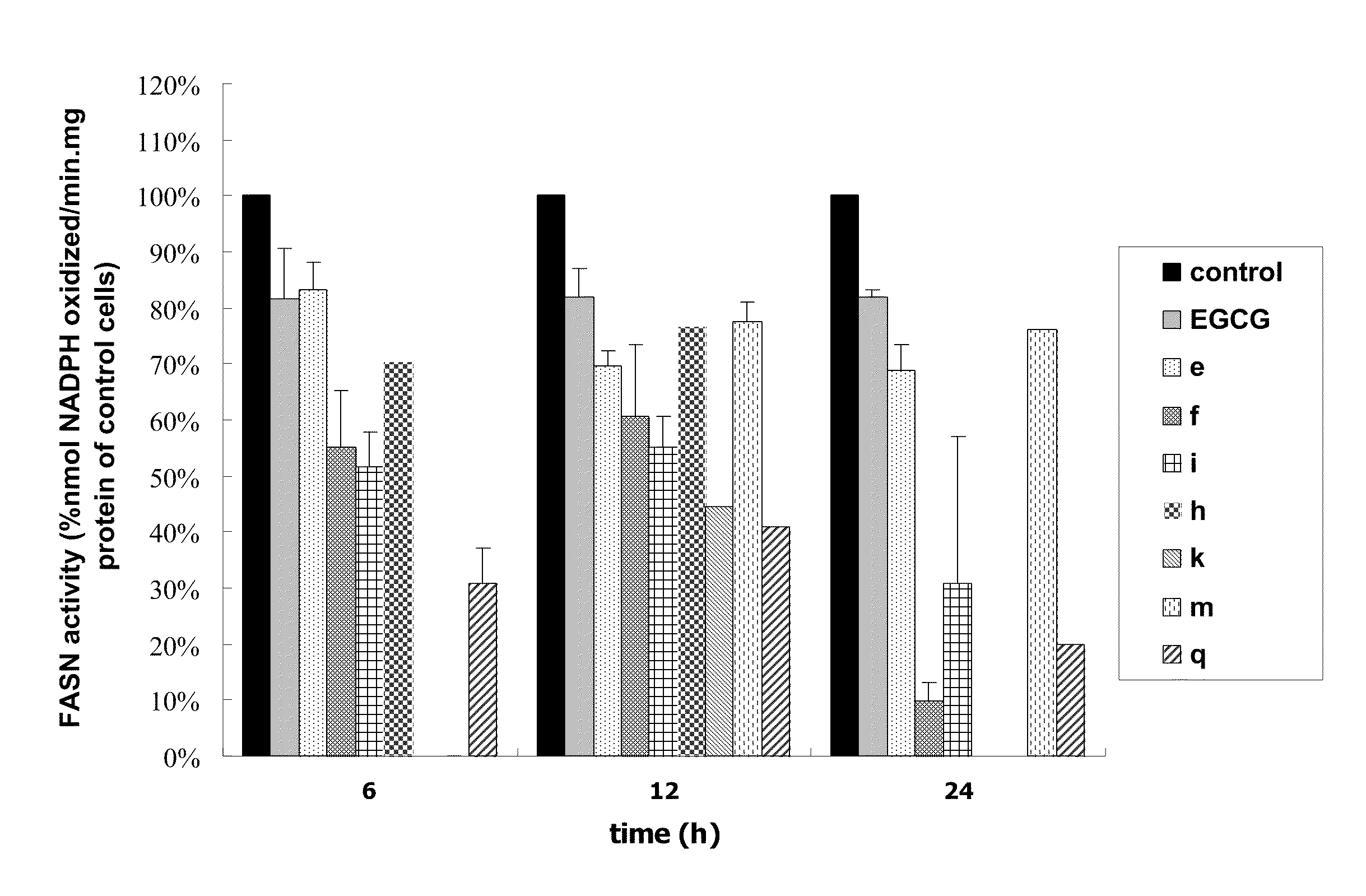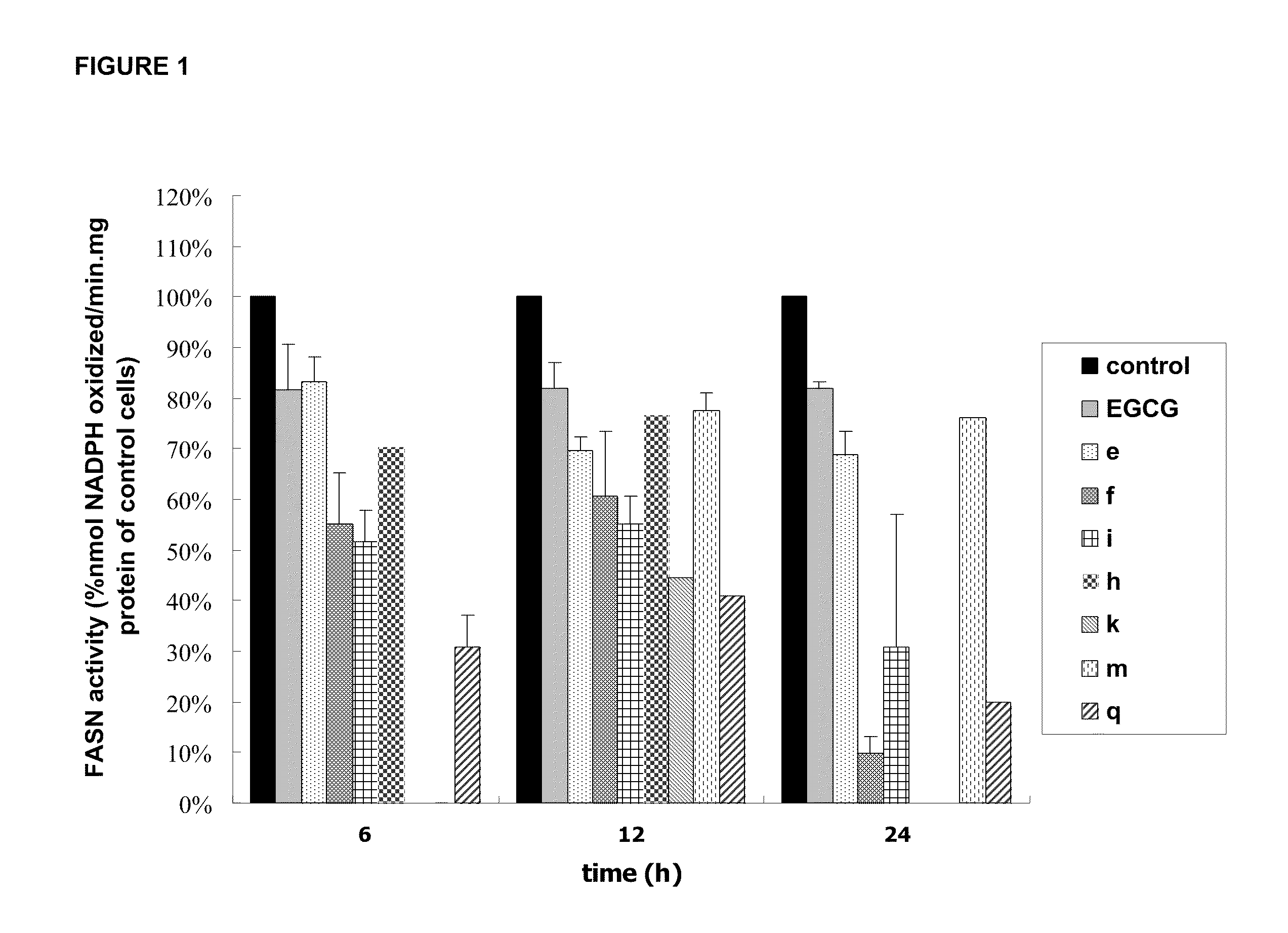Novel Polyhydroxylated Compounds as Fatty Acid Synthase (FASN) Inhibitors
a technology of fatty acid synthase and polyhydroxylated compounds, which is applied in the field of polyhydroxylated compounds, can solve the problems of limited efficacy of egcg in vivo, orlistat possesses an extremely low oral bioavailability, and limited use of c75 as in vivo anti-tumor agent, and achieves significant inhibition of fasn
- Summary
- Abstract
- Description
- Claims
- Application Information
AI Technical Summary
Benefits of technology
Problems solved by technology
Method used
Image
Examples
example 1
Synthesis of Compounds of General Structure (I). General Procedure. (See Scheme 1)
[0109]Carboxylic acid of formula (IV) (2.2 equiv.) was treated with DCC (2.2 equiv.) and DMAP (0.2 equiv.) in dry tetrahydrofuran or with thionyl chloride (3.3 equiv.) in dry toluene, under an argon atmosphere for 30 min. Then, a solution of the dihydroxyderivative of formula (II) (1 equiv.) in THF or pyridine was added dropwise, and the reaction mixture was stirred at 40-50° C. overnight. The mixture was filtered and the solvent was evaporated to dryness under reduced pressure. The crude was resuspended in dichloromethane and washed with a 5% aqueous solution of sodium bicarbonate. The organic layer was dried and after evaporation of the solvent the residue was purified by column chromatography in silica gel using the appropriate eluent, to afford the protected intermediate of general formula (V).
[0110]Alternatively, the carboxylic acid of formula (III) (1.1 equiv.) was treated with dihydroxyderivativ...
example 2
1,2-bis[(3,4,5-trihydroxybenzoyl)oxy]benzene (a)
[0113]
[0114]The title compound was prepared following general procedure described in example 1, starting from gallic acid and pyrocatechol as starting materials.
[0115]Yield: 37% (a), 44% (b); mp: 210° C. IR (KBr): 3427, 1689, 1624 cm−1. 1H NMR (CD3OD): δ 7.08 (s, 4H), 7.29-7.37 (m, 4H). 13C NMR (DMSO): δ 109.1 (4C), 118.1 (2C), 123.2 (2C), 126.0 (2C), 142.0 (4C), 145.0 (4C), 163.5 (2C). MS: M−H=412.9.
example 3
1,3-bis[(3,4,5-trihydroxybenzoyl)oxy]benzene (b)
[0116]
[0117]The title compound was prepared following general procedure described in example 1, starting from gallic acid and resorcinol as starting materials.
[0118]Yield: 68% (a), 38% (b); mp: 194-195° C. IR (KBr): 3370, 1718, 1618, 1200 cm−1. 1H NMR (CD3OD): δ 7.06-7.14 (m, 3H), 7.20 (s, 4H), 7.48 (t, J=8.4, 1H). 13C NMR (CD3OD): δ 110.7 (4C), 117.1 (2C), 120.3 (2C), 130.8 (2C), 140.8 (2C), 146.8 (4C), 153.3 (2C), 166.7 (2C). MS: M−H=412.8.
PUM
| Property | Measurement | Unit |
|---|---|---|
| concentrations | aaaaa | aaaaa |
| pH | aaaaa | aaaaa |
| temperature | aaaaa | aaaaa |
Abstract
Description
Claims
Application Information
 Login to View More
Login to View More - R&D
- Intellectual Property
- Life Sciences
- Materials
- Tech Scout
- Unparalleled Data Quality
- Higher Quality Content
- 60% Fewer Hallucinations
Browse by: Latest US Patents, China's latest patents, Technical Efficacy Thesaurus, Application Domain, Technology Topic, Popular Technical Reports.
© 2025 PatSnap. All rights reserved.Legal|Privacy policy|Modern Slavery Act Transparency Statement|Sitemap|About US| Contact US: help@patsnap.com



